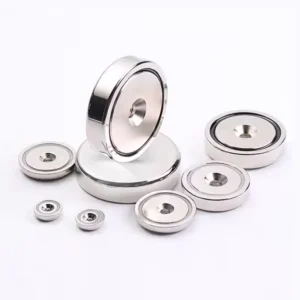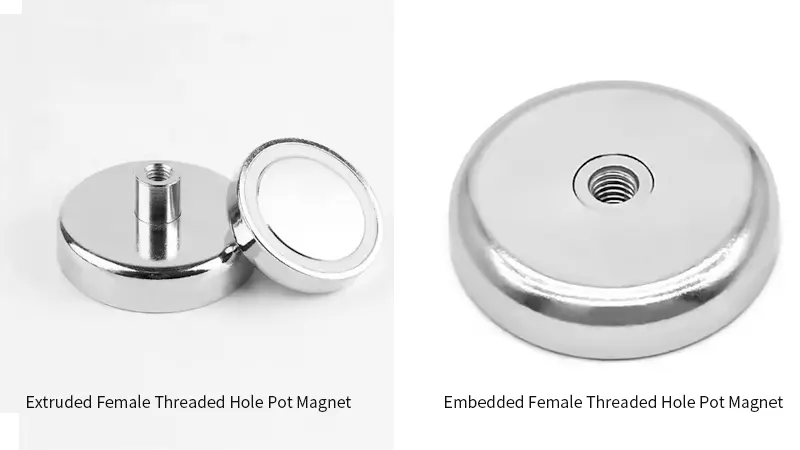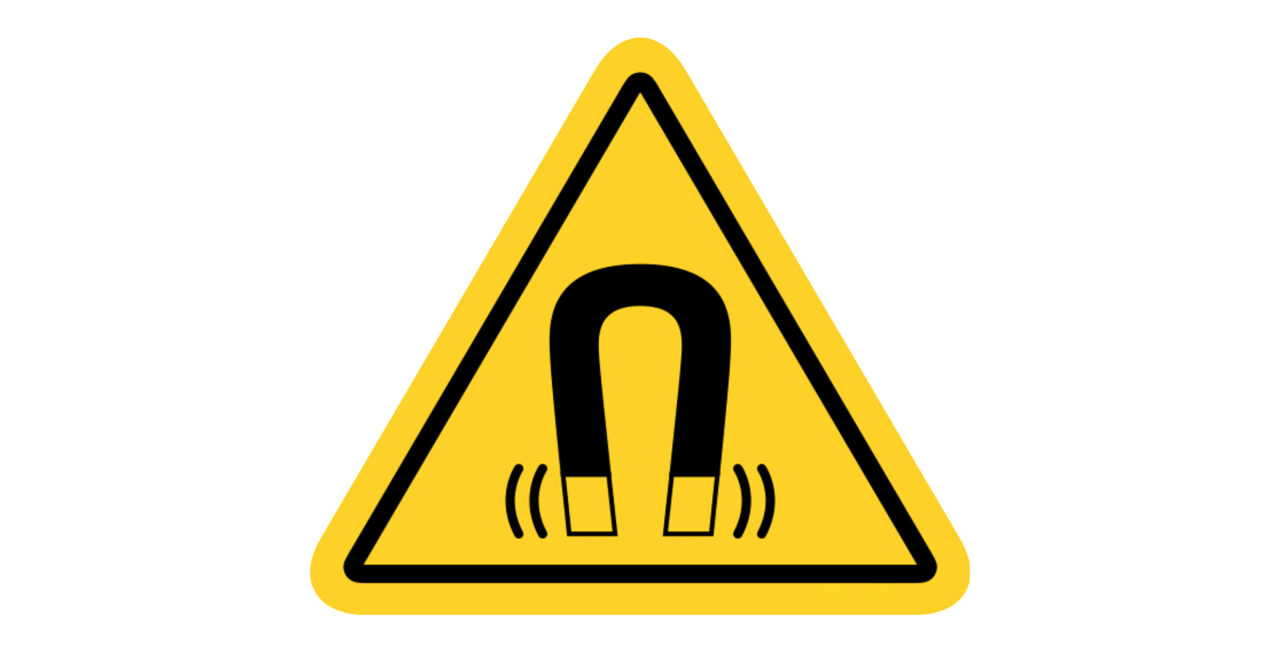The magnetic parts of the pot magnet is a magnetic part that nursing magnets in a metal shell. Compared with other magnets, the pot magnet has only one active magnetic surface, and the magnetic surface of other facial faces is non -magnetic or very weak. Due to its unique functionality and powerful maintenance, pot magnets are widely used in all walks of life. However it is not easy to choose the correct pot magnet. You need to understand the different structures of the pot magnetic set, and fully consider the best choices such as the required magnetic strength, environment and cost.
What are the different types of pot magnets available?
There are different types of pot magnets available. Understanding different types of pot magnets can help you choose the right solution for your specific needs. Now let’s explore the main types of pot magnets, their unique features, and their common applications.
Countersunk Pot Magnets
Countersunk pot magnets are designed with countersunk holes. These holes can be securely fastened using screws. Basically, this countersunk design allows the screw head to lie flush with the surface of the magnet. This bond ensures a neat and stable installation. And, these magnets are often used in situations where a flat, secure mount is required. For instance, you can use it in situations such as furniture assembly, signage, or other installations that require a low-profile connection. At Osencmag, we offer custom options for countersunk pot magnets. Our production includes a variety of sizes, magnetic strengths, and coating types (e.g., nickel, and epoxy) to meet your specific application.
Threaded Hole Pot Magnets
Threaded Hole Pot Magnets are like the Swiss Army Knife of the magnet world. This type of pot magnet is very versatile and very reliable. They come with a threaded hole in the centre. This type will allow you to attach a variety of fixtures or mount them to threaded rods. Particularly, they are very useful in situations where the magnet needs to be frequently repositioned or adjusted. They are available in two main configurations:
- Extruded Female Threaded Hole: In this configuration, there is an internally threaded hole that is slightly raised above the surface of the magnet. This type of threaded hole pot magnet has a raised design. Also, this design allows for easy access to bolts, hooks, or other accessories. This design provides a secure hold. Furthermore, this design is useful in applications where the magnet needs to be attached to another component or where adjustments may need to be made.
- Embedded Female Threaded Hole: In this configuration, the threaded hole is embedded within the pot magnet body. So, this design is best for a more streamlined and secure connection. This design is ideal for applications where the magnet needs to be flush with the surface. Ultimately this design will reduce the risk of snagging or damage. For all these reasons it is often used in machine assembly, metalworking, and other industrial applications where precision and durability are critical.
At Osencmag, we provide customization services for both types of configurations of threaded hole pot magnets. We make sure to provide you with products that will meet your specific requirements. For your specific needs, we can customise thread size, magnet size, and surface coating, ensuring optimal performance in your application.
Threaded Stud Pot Magnets
Threaded stud pot magnets come with an externally threaded stud protruding from the centre of the magnet. This design will allow you easy attachment to a variety of surfaces or objects. For example, this type of pot magnet is widely used in applications that require a secure, permanent connection. You can use this type in areas such as tool holders, fixtures, and assembly lines. Threaded studs provide a reliable and secure fastening method. Furthermore, these threaded stud pot magnets can be customised in length, diameter, and thread specifications to suit your specific needs. At Osencmag, we provide customization of the length of the studs and the coating of the magnets. For coating we have different options such as zinc or nickel, to suit your specific requirements to protect the magnets and increase their durability in harsh environments.
Eyebolt Pot Magnets
If you’ve ever needed to hang a heavy object from a ceiling or beam, then you know the value of a strong magnet. Eyebolt pot magnets feature a removable eyebolt, making them ideal for hanging or suspending objects. Eyebolts can be quickly installed and removed, providing a flexible solution for temporary or adjustable installations. These magnets are often used in architectural, exhibition, and retail environments where objects need to be securely hung, but may need to be repositioned. With our custom service, you can choose the size, magnetic strength, and coating of the ring pot magnets to ensure that the magnets work reliably in a variety of conditions.
Hook Pot Magnets
Hook pot magnets are very similar to Eyebolt pot magnets. The hook pot magnets use a hook instead of a ring magnet. This type of pot magnet provides a practical and easy solution for hanging items such as tools, cables or decorative items. The hook design allows for easy access and adjustment. This design makes these magnets ideal for workshops, garages and other environments where organisation and flexibility are key. For hook pot magnets, at Osencmag, we offer custom hook pot magnets with options for different hook sizes, magnet strengths and coatings. Our customization ensures the magnets meet the specific needs of your application.
Rubber Coated Pot Magnets
Rubber-coated pot magnets are the best type for delicate surfaces. We know we never want to scratch delicate surfaces, in that case, rubber coated pot magnets come in handy. This type is designed in a way that it protects delicate surfaces from scratches and provides greater friction for a more secure hold. Furthermore, the rubber coating also resists corrosion and environmental damage. This design makes these magnets suitable for outdoor or wet environments. This type is widely used in applications involving glass, polished metal or painted surfaces where protection and stability are critical. At Oscenmag, we offer mass production of rubber-coated pot magnets with customizable coating thickness, colour and magnetic strength that can be tailored to your specific needs.
How to choose the right pot magnet?
Now that we have the details of the different types of pot magnets and their unique applications, it’s time to choose the right pot magnet for your needs. We know, there are differences in types, coating material and mounting options. It takes a balance of basic knowledge and practical thinking to make the best choice. But don’t worry, we’re here to help guide you through it. Below we are going to enlist some important factors that you should consider to choose the right pot magnet for your needs.
Consider the Magnetic Material
The type of magnetic material is one of the basic factors to determine the performance of the magnetic material. There are usually three types of material used in pot magnets. These materials are neodymium iron boron (NdFeB), samarium cobalt (SmCo), and ferrite (ceramic). Each material has different properties, advantages, and disadvantages. Let’s find more details about these three types of materials;
- Neodymium Magnets: These types of magnets are the strongest permanent magnets available and offer excellent holding power. They are ideal for applications that need to be compact and have a high force/size ratio. However, they are sensitive to temperature and corrosion. That means, that if your environment is humid or subject to temperature fluctuations, then the right neodymium magnet model and coating is critical to consider before purchase.
- SmCo Magnets: The next type we have here is SmCo magnets. This type is not as strong as Neodymium magnets. SmCo magnets are very resistant to corrosion and can easily withstand high temperature ranges. They are suitable for extreme environments where both magnetic force and durability are critical.
- Ferrite Pot Magnets: The next type of material is Ferrite Pot Magnets. This type is lower in bonding power, however, and offers a more effective solution. This makes them ideal for large-scale applications where magnetic strength is not a primary consideration. They also perform well in high-temperature environments and are naturally corrosion-resistant.
So, when deciding on a material, consider the specific needs of your application. Also, consider what types of holding force are required. Also, consider environmental conditions, and budget constraints. At Osencmag, we offer custom pot magnets in all of these materials, size and shape. We ensure you get a solution that is exactly what your project requires.
Evaluate the Usage Environment
The next very important consideration is the environment where the pot magnets are going to be used. The environment plays a crucial role in selecting the right one. To evaluate this, you need to consider factors such as temperature, exposure to moisture, and the type of surface the magnet will be in contact with must be considered:
- Temperature: Neodymium magnets, for example, lose strength at high temperatures. So, in that case, if your application involves heat, you should consider choosing a SmCo magnet. As this type can maintain its performance in extreme conditions. Furthermore at Osencmag, we can customise pot magnets with temperature-resistant grades to suit your specific operational environment.
- Corrosion: If the magnet will be exposed to moisture or chemicals, then choosing the appropriate coating is essential. We know neodymium magnets are often coated with nickel, zinc, or epoxy to protect against rust and corrosion. On the other hand, rubber-coated pot magnets are also available for delicate surfaces. For this reason both protection and enhanced grip.
- Surface Type: The surface where you are going to apply pot magnets also impacts your choice. For example, smooth, flat surfaces allow for maximum contact and holding force. On the other hand, uneven or textured surfaces might require a magnet with a specialised coating or design to maintain a secure hold.
Balance Cost with Performance
We all want to choose the most powerful and durable magnets. However, we also need to balance the cost with the features of pot magnets. For example, if your application doesn’t require extreme magnetic strength, a ferrite pot magnet is a good choice. This type offers a more cost-effective choice than a neodymium one. Moving on, the right coating can also save costs while still meeting the performance requirements you want.
Determine the Mounting Options
The last factor to determine is the mounting option. As we mentioned, pot magnets come with different options. There are holes you can screw into, little posts you can thread things onto, also there are hooks and loops. Here let me quickly share some popular mounting options;
- Countersunk Holes: This mount option is ideal for flush mounting. Also, great for applications where the magnet needs to sit flat against a surface.
- Threaded Studs: For easy attachment and removal, the threaded studs mount option is best. It’s suitable for applications where the magnet might need to be repositioned or adjusted frequently.
- Hooks and Eye Bolts: This option is perfect for hanging objects. It is best to use at retail displays or workshop environments.
It’s very important to select the right mount options to ensure your magnets will be easy to install and durable according to application.
At Oscenmag, we provide custom production services that allow you to specify the exact type of mounting that suits your needs. You can choose from standard options to unique configurations. Remember, choosing the right pot magnet is not very complicated process. You just need to have tth the right knowledge and a good understanding of your application’s requirements, and you can select a magnet that meets your needs.
How are pot magnets different from ordinary magnets?
The main difference between a pot magnet and a regular magnet is in its design and how it is used.
We know regular magnets, which have the magnetic field exposed on all four sides. However, pot magnets have a steel casing (or “pot”) surrounding them. This casing helps to focus the magnetic field on one side. This feature enhances the holding force in that direction while protecting the magnet from damage on the other sides. In short, pot magnets are great for durability applications. The clamping/pulling forces in this type when in direct contact are generally higher than traditional standard magnets. Regular magnets are better for general magnetic purposes.
What materials are used in pot magnets?
Pot magnets are mainly composed of two parts: the inner core and the outer steel shell.
The core has a variety of permanent magnet material options, each with its own advantages. Usually we will choose neodymium magnets, which are stronger than ferrites, but also more expensive. Of course, there are also samarium cobalt magnets, which can better cope with higher temperatures, making them suitable for harsher environments.
The outer steel shell is also key, which helps to concentrate and guide the magnetic force, directing it to the exposed surface. This improves the overall retention of the pot magnet. Therefore, the core material used in the manufacturing process, as well as the steel shell, jointly determine the performance of the pot magnet.
Where are pot magnets commonly used?
Pot magnets are widely used in industrial applications, such as manufacturing, construction, and retail. This type is perfect for holding, lifting, or positioning objects due to their concentrated magnetic force and durability.










